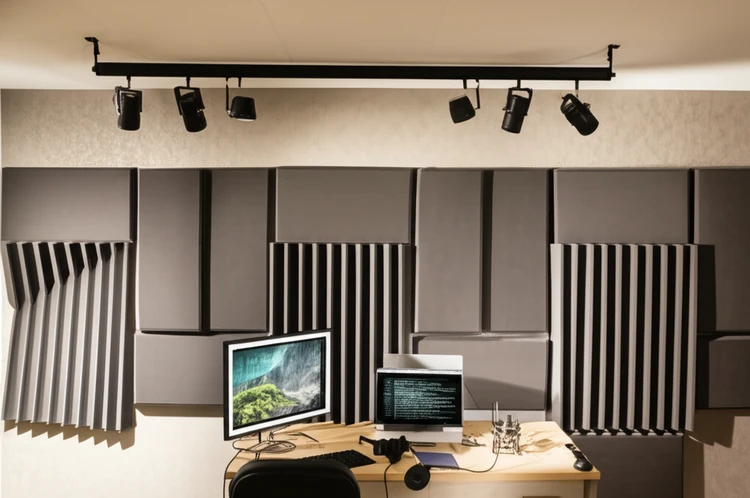
Creating a professional-grade soundproof recording studio is paramount for capturing pristine audio. Whether you’re a seasoned producer or an aspiring musician, a well-designed studio minimizes external noise intrusion and controls internal acoustics, creating an ideal environment for high-quality recordings. Achieving this requires careful selection and implementation of soundproof studio materials and proven techniques.
This comprehensive guide delves into the crucial aspects of building a soundproof studio, providing in-depth insights and practical advice to help you achieve professional results. From choosing the right location to selecting the most effective soundproof studio materials and implementing advanced soundproofing techniques, this article equips you with the knowledge to transform your recording space.
The Fundamentals of a Soundproof Recording Studio
A soundproof recording studio serves a dual purpose: preventing external noise from infiltrating the recording environment and containing internal sounds to prevent disturbance.
This involves understanding two key principles:
- Sound Isolation: This focuses on blocking sound transmission through various structural elements, including walls, floors, ceilings, doors, and windows. Effectively isolating sound requires careful consideration of materials and construction techniques.
- Sound Absorption: This involves minimizing sound reflections within the room to create a balanced and controlled acoustic environment. Proper sound absorption ensures clarity and accuracy in recordings.
Common challenges include mitigating low-frequency noise, addressing structural vulnerabilities (flanking paths), and selecting appropriate soundproof studio materials that align with budget and space limitations.
Selecting the Optimal Location for Your Studio
Key Location Considerations:
- Proximity to Noise Sources: Minimize proximity to significant noise sources such as busy streets, railways, airports, or noisy neighbors.
Conduct a thorough noise assessment to identify potential problems. Consider using a sound level meter to quantify the ambient noise levels.
- Structural Integrity: Prioritize spaces with robust and dense walls. Concrete or brick structures generally provide better sound isolation than lighter frame constructions.
Assess the existing structure for weaknesses and plan reinforcements accordingly.
- Room Dimensions: Irregularly shaped rooms can help minimize standing waves and echoes, which can negatively impact acoustic quality. Consider the room’s dimensions and proportions in relation to the intended use of the studio (e.g., vocal recording, instrument tracking, mixing). Acoustic modeling software can be helpful in predicting room behavior.
Pro Tip: While basements often offer inherent sound isolation advantages, assess potential issues such as low ceilings, HVAC noise, and moisture problems.
A basement with noisy mechanical equipment might require additional soundproofing measures.
Essential Soundproof Studio Materials
Mass-Loaded Vinyl (MLV):
MLV, a dense and flexible material, adds mass to walls, ceilings, and floors, effectively impeding sound transmission. Its ease of installation makes it a versatile component in layered soundproofing systems. MLV is typically specified by its weight (e.g., pounds per square foot) which directly relates to its sound blocking performance.
Look for MLV with an STC rating appropriate for your needs.
Acoustic Foam Panels:
Primarily used for sound absorption, acoustic foam panels reduce reflections and improve clarity within the studio. Available in various shapes, sizes, and NRC ratings, foam panels can be strategically placed to control specific frequencies and optimize the room’s acoustic response. While they contribute to overall sound quality, they are not a primary soundproofing solution.
Soundproof Drywall (e.g., QuietRock):
Specialized drywall products like QuietRock offer superior sound-blocking capabilities compared to standard drywall.
Their multi-layered construction and viscoelastic damping core effectively reduce sound transmission. When combined with resilient channels and insulation, they form a highly effective soundproofing system.
Fiberglass Insulation:
Cost-effective and versatile, fiberglass insulation fills wall cavities and reduces both airborne and impact noise. Its density and thickness influence its sound absorption performance.
Be sure to choose insulation with the appropriate R-value for thermal insulation and consider its impact on sound absorption within the wall cavity.
Pro Tip: A layered approach utilizing a combination of soundproof studio materials maximizes effectiveness. For instance, layering MLV with fiberglass insulation and acoustic foam addresses different types of sound interference, optimizing both sound isolation and absorption.
Soundproofing Techniques for Walls, Floors, and Ceilings
Walls:
- Double Walls with Air Gaps: Constructing double walls with an air gap creates an effective sound barrier. The air gap decouples the walls, minimizing sound transmission.
The width of the air gap influences its effectiveness.
- Resilient Channels: These metal channels decouple drywall from wall studs, reducing vibration transfer and minimizing flanking noise. Proper installation is crucial for optimal performance.
- Acoustic Caulk: Sealing all joints, seams, and penetrations with acoustic caulk is essential to prevent sound leakage. Even small gaps can significantly compromise soundproofing efforts.
Floors:
- Dense Rubber Underlayments: Using dense rubber underlayments beneath flooring materials absorbs vibrations from foot traffic and equipment, reducing impact noise transmission.
- Floating Floors: Installing a floating floor by placing a layer of insulation between the subfloor and the finished floor isolates impact noise and enhances soundproofing.
Ceilings:
- Resilient Clips and Double Drywall: Using resilient clips and double drywall on ceilings minimizes sound transmission and improves sound isolation.
Consider using specialized soundproofing drywall for enhanced performance.
- Acoustic Baffles or Clouds: Incorporating acoustic baffles or clouds enhances sound absorption and improves the room’s interior acoustics by reducing reflections and controlling reverberation.
Pro Tip: Meticulously sealing all gaps and cracks with acoustic caulk ensures no sound escapes or enters through small openings, maintaining the integrity of the soundproofed environment.
Addressing Doors and Windows: Critical Soundproofing Points
Doors:
- Solid-Core Doors: Opt for solid-core doors due to their higher density and superior sound blocking properties compared to hollow-core doors. Consider using specialized soundproof doors for maximum performance.
- Door Sweeps and Weatherstripping: Installing door sweeps and weatherstripping seals gaps at the bottom and sides of the door, preventing sound leakage and improving isolation.
Windows:
- Double or Triple-Pane Windows: Replacing single-pane windows with double or triple-pane alternatives significantly reduces sound transmission. The added air gaps and laminated glass improve sound insulation.
Consider windows with different thicknesses of glass to disrupt resonant frequencies.
- Soundproof Window Inserts or Curtains: Adding soundproof window inserts or heavy acoustic curtains provides additional noise reduction, particularly useful in noisy environments. These solutions are less permanent and can be tailored to specific needs.
Ventilation and HVAC Considerations
Maintaining adequate ventilation without compromising soundproofing can be challenging. Implement these strategies to address HVAC noise:
- Duct Mufflers or Silencers: Installing duct mufflers or silencers reduces HVAC noise and vibrations traveling through ductwork.
Select mufflers based on their insertion loss and airflow requirements.
- Acoustic Foam in Vents: Strategically placing acoustic foam inside vents dampens sound while maintaining air circulation. Ensure the foam does not restrict airflow significantly.
- Dedicated HVAC System: Consider installing a dedicated HVAC system for the studio to minimize vibrations and noise interference from the main building system. This provides greater control over noise and airflow.
Pro Tip: Design your ventilation system with bends and baffles within the ductwork to disrupt sound waves and further reduce noise transmission.
FAQ: Soundproofing Your Recording Studio
What’s the difference between soundproofing and acoustic treatment?
Soundproofing focuses on blocking sound transmission between spaces, preventing external noise from entering and internal sound from escaping.
Acoustic treatment aims to improve the sound quality within a room by addressing reflections, reverberation, and standing waves.
Can I soundproof a rented space?
Yes, several non-permanent soundproofing solutions are suitable for rented spaces. Acoustic curtains, portable panels, and soundproofing blankets can be easily installed and removed without causing damage to the property. Consult with your landlord before making any modifications.
What is the typical cost to soundproof a recording studio?
The cost of soundproofing a recording studio can vary significantly based on the size of the space, the desired level of sound isolation, and the chosen materials.
A basic DIY setup for a small room might cost between $1,000 and $3,000, while a professional-grade studio installation can range from $5,000 to over $20,000. Factors influencing cost include the complexity of the construction, the type of soundproof studio materials used, and labor costs.
Are there eco-friendly soundproofing materials available?
Yes, sustainable soundproofing options are available. Recycled cotton panels, cork, sheep’s wool, and certain types of sustainable acoustic foam offer effective sound absorption while minimizing environmental impact.
Research manufacturers committed to sustainable practices.
Conclusion: Building Your Ideal Soundproof Recording Studio
Creating an effective soundproof recording studio requires careful planning, strategic material selection, and meticulous implementation of soundproofing techniques. Addressing structural weak points, layering different soundproof studio materials, and optimizing internal acoustics are essential for achieving a professional-grade recording environment. Carefully evaluate your specific needs and budget, select the appropriate materials, and implement proven techniques to achieve superior sound isolation and a pristine recording space.
By investing time and effort in designing and constructing a properly soundproofed studio, you will create a space conducive to creativity and ensure high-quality audio recordings.
If you require further guidance or have a complex project, consulting with an experienced acoustician or studio designer is recommended.






